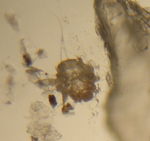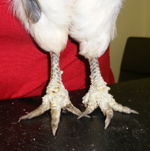Knemidocoptes
Jump to navigation
Jump to search
Knemidocoptes are burrowing mites of avian species. There are a number of important species infecting both production birds and pet animals.
- Life cycle similar to Sarcoptes spp.
Identification
Knemidocoptes are small round mites found in different locations on avian species dependant on the species of mite present. They have short legs similarly to most other species of burrowing mites. They may look similar to Sarcoptes spp. however they lack pegs and have dorsal striations instead. The presence of a terminal anus can also be used as a distinguishing feature.
Detection
The method of detection is a combination of the presence of clinical signs as well as identification of mites on a skin scrape or feather pluck.
Life Cycle
- Repeat treatments with acaricides needed
- Few products licensed for use in poultry
Important Species
- K. mutans
- This species is the cause of 'scaly leg'in poultry species as the mite burrows beneath scales on the leg and foot. This causes lameness as well as the presence of ragged legs and feed and distorted claws.
- K. gallinae
- This species is a depluming itch mite in poultry. The mite burrows into feather shafts and causes pain and pruritus causing birds to pull out their own body feathers.
- K. pilae
- This species is the cause of 'scaly face' psittacine birds. The mite attacks the bare areas of the face, beak, cere and body causing scaliness but little pruritus.

